All you need to know about your products!

| 3DNews Vendor Reference English Resource - All you need to know about your products! |
||||||
 |
||||||
|
|
||||||
Official tests of RV570 aka Radeon X1950 ProAuthor:Date: 18/10/2006 |
Much has been spoken about ATI's long-awaited novelties codenamed RV570 and RV560. Rumors are spreading, but one has to put a dot eventually. Today, we can finally tell you about this new video processor and officially present you the performance test results. We tested Radeon X1950Pro on a new test bench as well based on Intel Core Duo X6800, but ... all in good time.
We'll be introducing you to the new GPU which has come up to struggle for a place under the sun in the 199-229 $ pricing category using the X1950Pro video card by PowerColor. The video card is meant for use with the PCI-Express bus, is equipped with a VIVO/HDTV-out connector and two DVI Dual-Link connectors with support for the resolutions 2048x1536 @ 85 Hz for analogous connection and up to 2560x1600 for digital connection.
The first thing what you can't help noticing is the huge cooler by Arctic Cooling. Of course, it's a bit strange seeing such a big cooler for cooling a chip of quite modest power consumption and made following the 80 nm process technology. However, in its struggle for quietness, TUL company whose trademark is just PowerColor decided not to save. That's its advantage.
Under the hood inside the cooler we found heat pipes and many radiator fins. The fan rotates at about 1000 RPM, that is, absolutely noiselessly. And we did not expect anything different from Arctic Cooling. By "thickness", the cooler takes up two standard slots, which has long been customary for solutions of this class.
To provide better heat rejection off the GPU, there is a copper base two which as many as 3 heat pipes are fastened. The memory chips are cooled due to their contact with the foot of the aluminum radiator via thermo interfaces.
The PCB design has much in common with a typical PCB used for high-end Radeons, but there are essential distinctions. First of all, the changes are about the power supply subsystem. The number of finer components has been almost halved, and the number of power components (closed with black radiators) is now merely 3, which is a direct evidence of quite modest power consumption appetites of RV570. Another interesting point is about two plates of pins which resemble of a SLI connector on NVIDIA video cards. Anyway, the purpose of these contacts on PCB Radeon X1950 Pro is the same – provide operation of two identical video cards in the CrossFire mode without a Master-card but using an adapter. We can state that ATI has admitted the efficiency of NVIDIA's approach to merging two video cards, but decided not to confine to a mere copying, but went on somehow further. The secret of two connectors is simple - ATI has used a bidirectional bus to exchange data between two video cards. As specialists at ATI assure, this should increase the efficiency of the CrossFire combination, but we still can't tell to what extent. We received a single specimen of test sample without whatever accessories. What is nice, in Radeon X1950 Pro the support for VIVO has been preserved, and the ATI Rage is still there where it should be.
The reverse side of the video card is abundant with fine components, but without anything outstanding. We can somehow notice that simplification of the power supply system has touched upon the reverse side of the PCB as well.
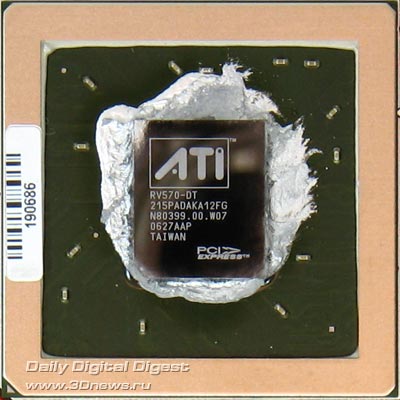
The ATI RV570 video processor offers 36 pixel pipelines, respectively – 12 texture units, the number of vertex units has remained the same and is now amounts to 8 units as before. AS you can see, the pipeline formula is identical to that we saw in X1900GT, which is no wonder. And X1950 Pro is just to come as its replacement, so X1900GT will be soon laid off production because its manufacturing cost is much higher. The clock speed of RV570 on the PowerColor board is 580 MHz.

Compare the cores of R580 and RV570. The area of the chips has been substantially reduced despite the additional units in RV570 to arrange the CrossFire.

The overall capacity of the video memory makes 256 MB assembled of 8 chips made by Samsung. It uses popular video memory of 1.4 ns access time and of 1400 MHz DDR nominal speed. The memory runs at this frequency. The memory bus width, as it should be, is 256-bit.
These are perhaps all the details which we'd like to mention for now. At the same time, batch-produced models may demonstrate a wide scattering in both the cooling system used an in the frequencies. But we can get an idea of the performance of RV570 already now. Now on to the benchmarking.
This time, we did not run overclocking tests. On the moment of tests, none of the utilities which we normally use to measure frequencies of video cards was able to reduce the nominal frequencies of X1950Pro and they were constantly reset to the defaults. As regards the thermal mode, then due to the finer process technology, small power consumption of the new chip and the effective cooler by Arctic Cooling the temperature of the video chip under load did not exceed 55°C. The new chip does offer overclocking potentials, at least in terms of the temperature. We'll find out what it is like in reality in the nearest future.
Today we are comparing performance of Radeon X1950Pro versus the performance of the following video cards – Radeon X1900GT as an immediate predecessor, GeForce 7900GT/GS as close representative of the same class and, in case of 7900GS – close at the target price $199, as well as Radeon X1900XT 256 MB which is a representative of a higher-end sector.
To start with, we are introducing you to the results of tests run at out proven good old test bench. Then we'll be comparing it versus what we got on a powerful modern test bench based on the Intel Core Duo.
|
Bus
|
PCI-Express
|
|
CPU
|
|
|
MB
|
|
|
Memory
|
|
|
OS
|
WinXP + SP2 + DirectX 9.0c
|
|
PSU
|
Hiper 525W
|



By the results of tests at synthetic benchmarks, we can say that the performance of Radeon X1950 Pro is insignificantly superior to the results of X1900GT due to the higher operating speed of the memory. As regards the immediate "price" competitor GeForce 7900GS (and 7900GT as well), the advantage is more substantial, except 3DMark’03 where NVIDIA video cards perform traditionally better.



The general alignment of forces is preserved in Half-Life 2 as well. Radeon X1950 Pro takes a lead over X1900GT and 7900GS, and even 7900GT at high resolutions as well.

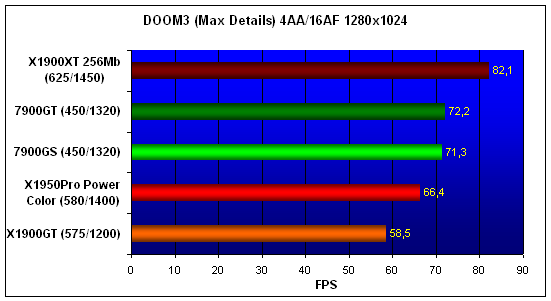

As was expected, at DOOM 3 the situation is changing to the contrary. We see that even X1900GT is already at the very bottom of the table, and X1950 Pro is taking an interim position between it and 7900GS.



At F.E.A.R., the results for X1950 Pro, 7900GS and 7900GT are very close to one another, so we can't determine a certain leader.
The need for a change in test configuration has long been there. Today, we are glad to introduce our new high-performance test configuration which has appeared thanks to contribution from our friends and partners. This time onwards, we'll be testing video cards on its base. Meet the new hero!
|
Bus
|
PCI-Express
|
|
CPU
|
|
|
MB
|
|
|
Memory
|
|
|
OS
|
WinXP + SP2 + DirectX 9.0c
|
|
PSU
|
Thermaltake ToughPower 750 W
|
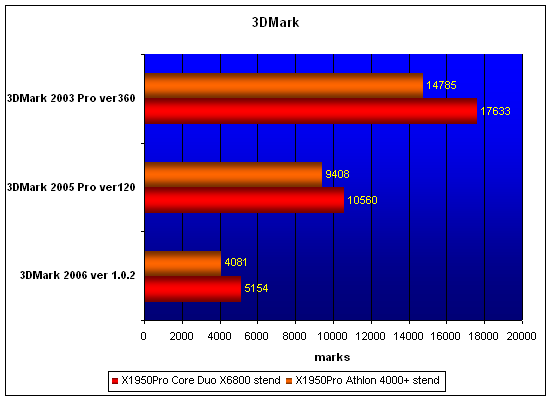
The bright red color depicts results for the new test configuration, and orange - for the old. The very first tests run on a new configuration demonstrate a substantial boost in marks. It's the way it should be. While in 3DMark’06 the CPU tests are included into the overall score of points, all the other marks for default modes are rather CPU-bounded and also gain boost due to the rise of CPU performance. So, what do we get at real applications?
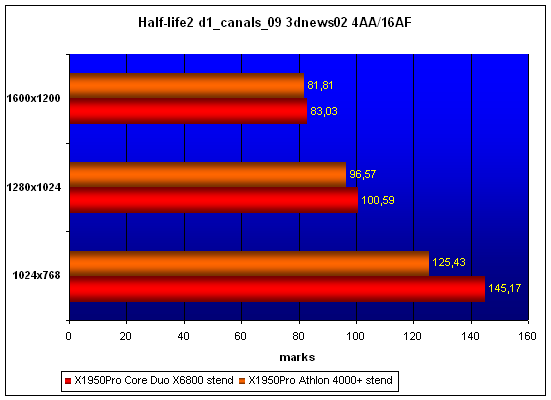
At 1024х768, the difference in test results at different test configurations is maximum. But this difference turns small as the resolution goes up.
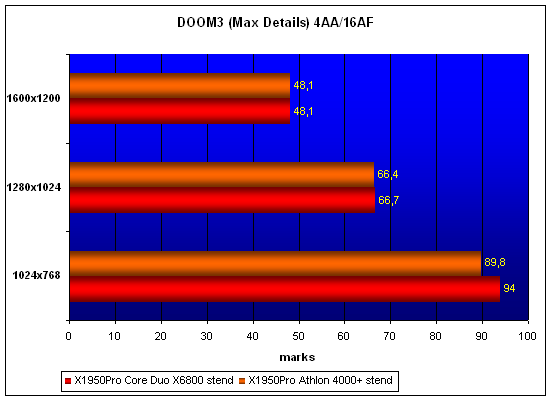
We can see the same for DOOM 3 as well. The results produced in different configurations for 1280x1024 and 1600х1200 are practically identical.
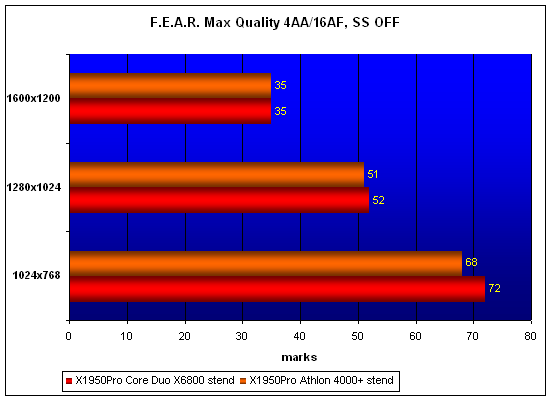
The same trend is preserved also in F.E.A.R.
For those who carefully read the article "CPU-boundedness of the video system. Part I - Analysis", there is no wonder about that. As was shown in that article, if the video card runs in the "hard" mode, its line of results takes the shape of a "shelf" and the FPS no longer depends on the power of the CPU.
We placed emphasis on that in order to show the difference in "marks" and results of real tests. Of course, a rope is longer in "3DMarks" :), but because in moving towards a new test configuration the video card remains the same, then in real applications we see the same FPS. This is just what was demonstrated.
On the whole, we can state that Radeon X1900GT has acquired a dignified heiress – thrifty, low-noise, and even more powerful. The recommended price 199-229 $ makes Radeon X1950 Pro a good candidate for purchase and a serious competitor to GeForce 7900GS. Of course, the retail prices for X1950 Pro will differ from the recommended towards increase, but that is characteristic of all the novelties emerging onto the market. At that, we are finishing a review of the Radeon X1950 Pro specimen based on the new ATI RV570 video processor. We are anxiously looking forward to trying batch-produced products based on this promising GPU.
|
|||||